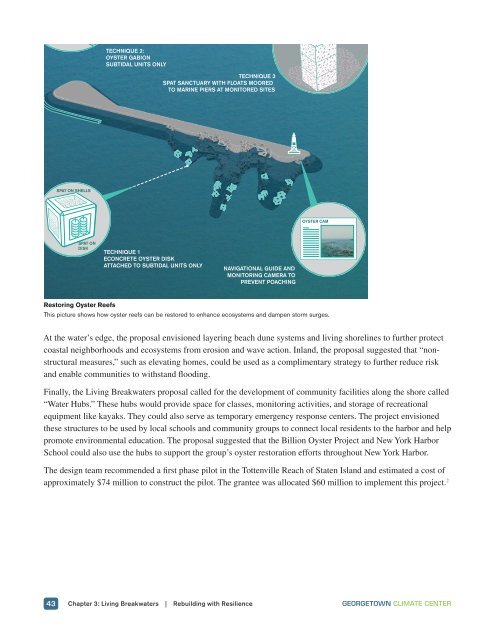Rebuilding with Resilience
dw0r306aHfX
dw0r306aHfX
You also want an ePaper? Increase the reach of your titles
YUMPU automatically turns print PDFs into web optimized ePapers that Google loves.
of GABION Staten Island to<br />
their ‘islandness.’<br />
- S.I. Teacher<br />
“<br />
“<br />
TECHNIQUE 2:<br />
OYSTER GABION<br />
SUBTIDAL UNITS ONLY<br />
Keep going!<br />
- DEC Employee<br />
“<br />
TECHNIQUE 3<br />
SPAT SANCTUARY WITH FLOATS MOORED<br />
TO MARINE PIERS AT MONITORED SITES<br />
SPAT ON SHELLS<br />
OYSTER CAM<br />
SPAT ON<br />
DISK<br />
TECHNIQUE 1<br />
ECONCRETE OYSTER DISK<br />
ATTACHED TO SUBTIDAL UNITS ONLY<br />
NAVIGATIONAL GUIDE AND<br />
MONITORING CAMERA TO<br />
PREVENT POACHING<br />
Restoring Oyster Reefs<br />
This picture shows how oyster reefs can be restored to enhance ecosystems and dampen storm surges.<br />
At the water’s edge, the proposal envisioned layering beach dune systems and living shorelines to further protect<br />
coastal neighborhoods and ecosystems from erosion and wave action. Inland, the proposal suggested that “nonstructural<br />
measures,” such as elevating homes, could be used as a complimentary strategy to further reduce risk<br />
and enable communities to <strong>with</strong>stand flooding.<br />
Finally, the Living Breakwaters proposal called for the development of community facilities along the shore called<br />
“Water Hubs.” These hubs would provide space for classes, monitoring activities, and storage of recreational<br />
equipment like kayaks. They could also serve as temporary emergency response centers. The project envisioned<br />
these structures to be used by local schools and community groups to connect local residents to the harbor and help<br />
promote environmental education. The proposal suggested that the Billion Oyster Project and New York Harbor<br />
School could also use the hubs to support the group’s oyster restoration efforts throughout New York Harbor.<br />
The design team recommended a first phase pilot in the Tottenville Reach of Staten Island and estimated a cost of<br />
approximately $74 million to construct the pilot. The grantee was allocated $60 million to implement this project. 2<br />
43 Chapter 3: Living Breakwaters | <strong>Rebuilding</strong> <strong>with</strong> <strong>Resilience</strong> GEORGETOWN CLIMATE CENTER


